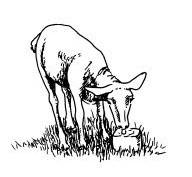Ruminant livestock production in the tropics is sometimes limited by the animals’ diets, which are often lacking in minerals necessary for good growth and health. Mineral content is quite variable in tropical plants and soils, and mineral uptake is complicated by many different factors.
Salt licks can provide the minerals that are often lacking, such as phosphorus, sodium, calcium and magnesium. Salt licks can be purchased to improve production, but limited cash and/or proximity to a town or village may prohibit doing so regularly. It is possible, however, to make your own salt lick out of local ingredients.
Different materials can be put into salt licks to provide the necessary nutrients. The simplest recipe for making a salt lick comes from Ibrahima Diallo of Veterinarians Without Borders (published in Baobab 21, December 1996).
The ingredients required are bones, salt and clay. To make bone meal, first burn, crush and sift the bones. (See EDN 55-1 for how to make bone meal.) Pound and sift clay from a termite mound. Then mix two parts rock salt, four parts bone powder and one part of termite clay and add enough water to create a paste. The paste can then be molded by putting it in wooden boxes, in wide metal bowls or calabashes with holes in them (for aeration), or in big tin cans lined with plastic bags (remove the salt lick when dry). Once dried, put the salt licks out for your livestock.
Another method of making a lick is with bone meal, cement, salt and sifted ashes. Mix everything together with enough water to make a paste, then mold and allow it to dry for two weeks until the cement has hardened. To make one block of salt lick (10 kg in weight), you will need 6.3 kg of salt, 1.5 kg of bone meal, 0.6 kg of ashes and 1.6 kg of cement. The salt block will improve in quality if you reduce the amount of salt and increase the bonemeal content

Add water, making sure that it is only enough to form the mixture in a mold. You should not be able to squeeze any water out of the mixture. As an option, some molasses can be added to sweeten and to help bind the mixture. Molasses should be added before the water since it will also provide some moisture.
Some farmers and community groups have started producing salt licks for sale in their village as an income-generating activity. Farmers in Kenya could not afford commercial salt blocks, but when some farmers’ groups started producing local salt licks, villagers began buying them. A half-kilo block sells for US$0.80. (From Baobab 28, March 1999).

A second limiting factor in livestock production is the poor digestibility of some feeds, especially in the dry season. When animals are getting mostly low-quality, low-protein feeds such as the dry stalks of cereals, they have a hard time digesting them and therefore tend to lose weight and decrease performance. To increase the amount of digestible matter, the animals need a source of nitrogen to help them break down their feed.
For ruminants only, extra nitrogen can come from urea blocks. The urea in blocks is utilized by the microbes in the rumen to manufacture protein, thus increasing roughage intake and improving weight gain. When coupled with the minerals added to the urea block, performance is improved.
Baobab 25, March 1995, describes how to make a urea block. You will need 1 kg of urea, 1.5 kg of cement, 6.5 kg of bran (or winnowings from beans), 1 kg of salt and 5-6 liters of water. Dissolve the urea in water and mix together the pounded salt, the bran and the cement. Slowly add the urea liquid to the dry ingredients until it is a thick paste. Put this in a mold and allow to dry for about two weeks. Again, molasses can be added in place of some of the water. Molasses helps to bind the urea in the block.
The urea in the block can be harmful to livestock if too much is consumed. It should be given to animals in controlled amounts, starting with small amounts and gradually increasing it over a period of several weeks. The most a cow or camel should consume per day is 500 g, and a sheep or goat not more than 120 g. Urea blocks are only used for ruminants such as cattle, sheep, goats and camels.
Cite as:
ECHO Staff 1999. How to Make Your Own Salt Licks and Urea Blocks. ECHO Development Notes no. 65